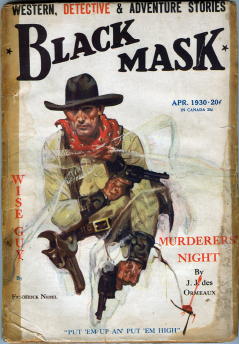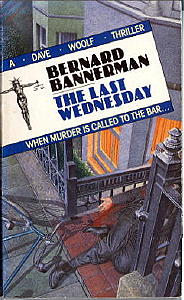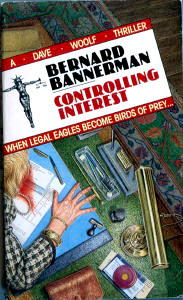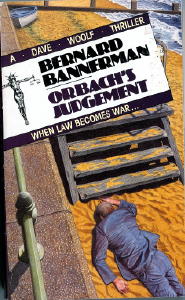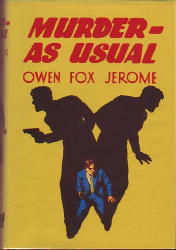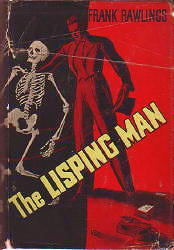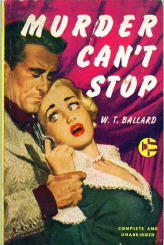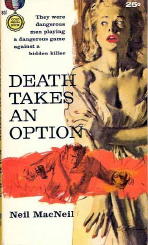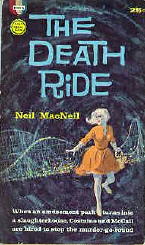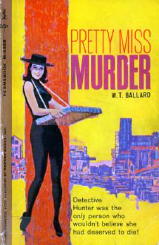July 2007
Monthly Archive
Thu 12 Jul 2007
Just as the word “noir” means many things to many people, it is not easy to define exactly was is meant by a “cozy” mystery. It’s usually a matter of saying “I can’t define it, but I certainly know one when I see one.” But pointing out examples is always good; also worth doing is a list of the common characteristics that cozies almost always seem to have.
Danna Beckett does a super job of both on her Cozy Mystery website, which she’s just told me about and which I recommend to you highly. You’ll find a long detailed alphabetical list of authors there, from Jeff Abbott and Alina Adams (*) to Cornell Woolrich and Eric Wright, as well as a smaller section of TV and movie cozies.
(*) Skipping over Pearl Abraham (not a mystery writer) and Peter Abrahams (not a cozy writer), but there are very good reasons why they’re included. Why make a list of mystery writers and not include your favorites? It works for me.
Wed 11 Jul 2007
Posted by Steve under
TV mysteries1 Comment
Hello Steve,
I would like to submit a follow-up on the interesting observations about The Dow Hour of Great Mysteries (for which, incidentally, Poe’s “The Murders in the Rue Morgue” and Collins’s “The Moonstone” were also planned, but remained unproduced) and Orson Welles Great Mysteries.
Orson Welles Great Mysteries, produced by Anglia Television (an independent British TV company serving the commercial network for the east of England), was a syndicated (taped) series of 26 half-hour episodes and was first broadcast in the London area from 6 July to 18 December 1974 (1st series) and then 18 September to 16 December 1975 (2nd series). The suitably haunting title music was by John Barry. Unfortunately, a very-unhaunting Orson Welles was brought in to introduce the stories, garbed in a black, swirling cloak and a slouch hat (suggesting the appearance of an Oliver Hardy as The Shadow).
The story sources for the individual episodes are as follows:
Captain Rogers (based on a story by W.W. Jacobs)
The Leather Funnel (Sir Arthur Conan Doyle)
A Terribly Strange Bed (Wilkie Collins)
La Grande Breteche (Honore de Balzac)
The Dinner Party (James Michael Ullman)
Money To Burn (Margery Allingham; dramatised by Michael Gilbert)
In the Confessional (Alice Scanlon Reach; with Milo O’Shea as Father Crumlish.
Unseen Alibi (Bruce Graeme)
Battle of Wits (Miriam Sharman)
A Point of Law (W. Somerset Maugham)
The Monkey’s Paw (W.W. Jacobs)
The Ingenious Reporter (Pontsevrez)
Death of an Old-Fashioned Girl (Stanley Ellin
Farewell to the Faulkners (Mirian Allen de Ford)
For Sale — Silence (Don Knowlton)
Inspiration of Mr. Budd (Dorothy L. Sayers)
An Affair of Honour (F. Britten Austin)
The Power of Fear (Lawrence Treat; dramatised by N.J Crisp)
Where There’s a Will (billed as an original script by Michael Gilbert, but wasn’t there an Agatha Christie story…?) Here, Richard Johnson plays Bruce Sexton.
A Time to Remember (James Reach)
Ice Storm (Jerome Barry; dramatised by N.J. Crisp)
Come Into My Parlour (Gloria Amoury)
Compliments of the Season (O. Henry)
Under Suspicion (Norman Edwards)
Trial for Murder (C.A. Collins and Charles Dickens)
The Furnished Room (O. Henry)
The script editor for the above series was John Rosenberg, who later became the producer for Anglia TV’s Roald Dahl’s Tales of the Unexpected (1979) and (now minus Dahl) Tales of the Unexpected (1980-88). The videotaped look and feel, rather disappointingly, was similar to the earlier Welles series.
Interestingly, during the year of Dow Hour‘s monthly presentations, 1960, a lesser-known genre author also had his works (or at least his characters) produced — as Diagnosis: Unknown (CBS, July-September). Lawrence G. Blochman’s police pathologist Dr Daniel Coffee was played by Patrick O’Neal (with Cal Bellini as Dr Motilal Mookerji and Chester Morris as Captain Max Ritter) in a series of only 10 hour-long episodes. The mystery here is that this fascinating-sounding series, which nobody seems to have seen, either back then or in more recent times, seems to have disappeared entirely. Fortunately, two of the Dr Coffee books (the collection Diagnosis: Homicide, 1950, and novel Recipe for Homicide, 1952) do crop up on AbeBooks.
Wed 11 Jul 2007
Posted by Steve under
AuthorsNo Comments
Hi Steve,
I’m a little late with this. The John Shepherd review reminded me to send you these comments.
Some 25 years ago, when I was researching the life of Norbert Davis, I came across a couple of little-known facts about W.T. Ballard. Did you know that Rex Stout and Ballard were cousins? That’s why they have the same middle name: Todhunter.
I also learned that Ballard did not have the use of his right arm. I suppose this means that in each of his most productive years he typed over a million words using one hand. I don’t know when or how he developed the handicap.
Wed 11 Jul 2007
Hi —
I’ve been searching for a mystery I read in about 1974 — it may have been several years old when I read it. Don’t know the author or title. The story takes place in NYC — a young medical student murders his pregnant girlfriend through some ingenious medical means. The friend or roommate of the murdered woman falls in love with the medical student and later figures out the truth about him. Since for some reason she cannot prove it, she marries the (now) doctor as a kind of daily punishment for him, with the truth disclosed in a letter kept with her lawyer “in case anything happens to her.”
I believe the author was a woman. The book was well written, and I’ve been wracking my brains for years trying to come up with the title and author. Seems the title had something to do with her ironic “punishment” of the murderous doctor. Any idea?
Tue 10 Jul 2007
Last night I dreamed I went to Pulpcon again. In retrospect, getting on the hotel shuttle bus on early Sunday morning on the way back to the Dayton airport, it seemed as if the four preceding days had simply flown by, and it still does.
Attendance was down once again, but not significantly, I’m told, from last year. The convention began the day after July 4th, and that was suggested as having a good deal to do with it. Sales were down also, or so I heard, but perhaps that was due to prices generally being up, on the pulps at least. With eBay as a backup, no dealer wants to sell his wares too low.
And the selection was limited, mostly because the supply of pulp magazines not already in collectors’ hands is diminishing at an ever-increasing rate. But there were plenty of pulp reprints in the dealers’ room, for those who want only to read the odd-ball titles, and tons of paperbacks, hardcover books (mostly science fiction), and other reading material in the room. When I say tons, I am not exaggerating.
Martin Grams had his usual pair of tables filled with DVDs of vintage TV shows, of which I resisted and bought only three: an obscure series on ABC in 1960, Dante, starring Howard Duff. I ought to look, but I believe that means I have 24 of the 26 total episodes. It’s a crime show in which night club owner Willie Dante (Duff) is trying to go straight, but his past keeps interfering.
Coincidentally enough, as you’ll see in a minute, Martin has just published his latest book on Old Time Radio, this one a history of the Sam Spade series, starring (for the first part of the run) none other than Howard Duff. I bought a copy, and if you were to happen to ask me, I’d tell you that you should too.
Most of the time at the show itself, disregarding periodic intervals for eating and visiting area bookstores, is spent by most everyone by walking around the dealers’ room and stopping for long talks with people on either side of the tables, fellow collectors you see perhaps only once or twice a year. Lots of discussion going on about what author’s works are going to be reprinted next, what big finds were made, how’s the family, and what are you looking for now?
Randy Cox (editor of Dime Novel Roundup) made his first appearance in three years. Six of us, Randy, Jim Goodrich, Paul Herman, Walter and Jim Albert, and I, spent much time dining out and catching up with each other’s lives at great lengths. By the way, one piece of crushingly bad news was the demise of the Breakfast Club, a small café we’d discovered and frequented many mornings over the past five or six years.
Mike Nevins also appeared, as full of bountiful energy as ever and promising me a new column for this blog as soon as he can do it. I also talked at length with Walker Martin, John Locke, Al Tonik, Ed Hulse and many others, including Jim Felton, whose enthusiasm for Robert Martin continues unabated and without bounds. Ed Hulse, publisher of Blood ’n’ Thunder magazine, won this year’s Lamont Award for his outstanding contributions to the hobby of pulp collecting. It was a popular choice.
Guests of honor were David Saunders, son of famed pulp artist Norman Saunders, and Glenn Lord, a long time administrator of Robert E. Howard’s estate.
And believe it or not, I bought a pulp, the one whose cover you see here. I was sorely tempted many many times, with hundreds of others I thought about, thought again, but did not buy. Every time I almost pulled the trigger, I thought of all the boxes of unread pulps I have in my basement and garage, and asked myself (foolishly, I know), do I really want to buy more?
In all but one case the answer was no, but the one case is an example of one that I do not have boxes and boxes of, Black Mask for April 1930. You can’t tell from the cover, which mentions only Frederick Nebel and J. J. des Ormeaux, but this issue also contains two Raoul Whitfield stories, one as by Ramon Decola, and an installment of “The Glass Key,” by Dashiell Hammett.
The condition is fairly iffy, but the stories are good. Maybe I’ll pick up Part Three next year. One can only dream, can’t one?
Tue 3 Jul 2007
Rather than be in town on the 4th for hamburgers and hot dogs, not to mention barbecue ribs, I’ll be flying to Dayton tomorrow for this year’s Pulpcon, where collectors of old pulp magazines, vintage paperbacks and all kinds of similar items gather to buy, swap and tell yarns of the ones that either they hooked or got away.
I’m sure I’ll see some of you there, or if you don’t read this until you get back, I’m sure you had a good time, too.
But I’m going to stay away from computers for a while, and there’ll be no postings until I’m home again, which will be next Sunday. The mid-summer hiatus may even be longer than that, I’m sorry to say. My son Jonathan is leaving home again. Next week he’ll be moving into a new place of his own a couple of towns north of here, and I’m the one who’ll be loading the SUV, driving the SUV, and unloading the SUV, not to mention waiting around for the real movers to bring his major stuff up from Maryland. (Well, he’ll help.)
My scanner’s gotten cranky on me, too. I’m not too happy with the sharpness on the images included in that last post, and I certainly don’t feel like dealing with it any more this evening. It’s time to take a break all around. You may as well assume I’ll be off for a week or so. I hope it’s no longer than that. In the meantime, don’t do anything rash and stay cool.
[UPDATE] 07-11-07. I’ve done some work on the images I was unhappy about last week. I think there’s some improvement, but maybe it’s wishful thinking. I’ll take another look tomorrow, but at the moment it’s ten in the evening, and there’s a book calling my name…!
Tue 3 Jul 2007
I’m always on the lookout for previously unknown and/or unidentified private eyes, the fictional variety. Kevin Burton Smith keeps a pretty good list on his Thrilling Detective website, but he doesn’t have them all. I’ve helped in adding a few, and I thought I had another one when I came across the books of Bernard Bannerman, who chronicled the adventures of one Dave Woolf, a London-based PI about whom I’ll tell you more in a minute.
It turns out, however, that Kevin has heard of Dave Woolf. He’s listed as a PI on his website, but only by name. There’s no page there for him, yet.
Here’s what Bannerman’s entry looks like in Crime Fiction IV, by Allen J. Hubin:
BANNERMAN, BERNARD; pseudonym of Andrew Arden (1948- )
* Controlling Interest (n.) Sphere 1989 [Dave Woolf; London]
* The Last Wednesday (n.) Sphere 1989 [Dave Woolf; London]
* The Judge’s Song (n.) Sphere 1991 [Dave Woolf; London]
* Orbach’s Judgment (n.) Sphere 1991 [Dave Woolf; London]
Under his own name, Andrew Arden has one mystery novel to his credit:
ARDEN, ANDREW (1948- ); see pseudonym Bernard Bannerman
* The Motive Not the Deed (n.) Talmy Franklin 1975 [London]
I don’t know anything about this book, but from the Internet, I have learned more about the author himself. Taken from his website:
Andrew Arden Q.C. has established himself as one of the leading authors on housing and local government law, editing or authoring several leading and authoritative texts in this area. In addition to materials written for practitioners, he has also written several texts designed as a more general introduction to these areas of law.
Fiction — the novels which appeared under his own name:
* The Motive Not The Deed, 1974
* No Certain Roof, 1984 [Landlord of working-class family wants to turn their house into flats.]
* The Object Man, 1987
* The Programme, 2001 [A law firm gets mixed up with a quasi-religious cult.]
If you may have gotten the feeling that legal matters have something to do with the cases that Dave Woolf works on, you’d be right. I hasten to add that I’ve not read any of them yet, but I’ve recently put together a complete set of his adventures, as told by Bernard Bannerman.
Each of the first two books mentions the other as a selling point, so perhaps they came out at the same time. But one has a lower publisher’s number than the other, so I’ll go with that one as the first of the two. (The same is true for the second pair of books.)
Quoting from the back cover of each of the books:
THE LAST WEDNESDAY. Sphere 0382, pbo, 1989.
No one falls out as viciously, as painfully or as messily as lawyers. Jack Nicholas, left-wing barrister, was supposed to have died in an accident. Drunk, said the coroner. Murdered, said his mother. Enter Dave Woolf, ex-solicitor, boozer and down-at-heel private eye.
Even before Woolf starts asking questions, he finds that he is investigating not one death, but the wholesale despatch of Jack Nicolas’ erstwhile colleagues. There is very little for Woolf to go on – as he treks through the glitz and sleaze of London, through France and Norway in search of an elusive German – other than the apparent coincidence that all the deaths had occurred on the last Wednesday of every month.
CONTROLLING INTEREST. Sphere 0383, pbo, 1989.
“The body of a woman solicitor was discovered by staff arriving yesterday morning at the Holborn offices of the prestigious London solicitors, Mather’s. Katrina Parkhurst, 32, has been shot. Police are investigating.”
A murder on the premises is bad news for a law firm. It discourages clients. It also discourages recruits which is damaging to a firm like Mather’s with a reputation, a lot of clients, but very few partners. But, as Dave Woolf, one-time lawyer, part-time boozer and (almost) full-time private eye realizes, a thorough professional would prefer a murder to a leak any day of the week. Dead men can’t leak information on gambling debts, treachery, the darker side of freemasonry, and a dodgy business dating back forty years …
THE JUDGE’S SONG. Sphere 0520, pbo, 1991.
It was, as Dave Woolf said, “the sort of thing that doesn’t happen in England.” High-count corruption, gangsters, fire-bombs and a bit of murder on the side – all of it against the backdrop of a family drama raging through London, the West Country and the South of France.
It’s not the sort of thing that solicitors ought to be investigating. But Woolf is not ordinary solicitor. Back in the legal fold after a spell as a private eye, he’s roped into a spot of detection for the usual reason – an irresistible fee. Sustained by hefty slugs of Southern Comfort, Camels and his new Aussie sidekick, he’s ready to haul a few skeletons out of family cupboards. The trouble is, they’re still alive …
ORBACH’S JUDGEMENT. Sphere 0521, pbo, 1991.
Dave Woolf, solicitor and private eye, has had respectability thrust upon him. He’s also been saddled with the most sensational case of his career.
High Court Judge Sir Russell Orbach is a pillar of the establishment and a doting guardian to the orphaned Frankie. In public, that is. In private, according to Frankie’s famous half-sister, he’s a murderer. What’s more, she’s going to say so n her forthcoming autobiography. Would Woolf, asked the petrified publisher, check up on this bizarre accusation?
It’s just up Woolf’s street; he specialises in investigating the misconduct of members of the legal profession. It’s sometimes like biting the hand that feeds you; but when that hand is adept at bullying, blackmail and bundling bodies into the ocean, it’s Woolf who’s in danger of being bitten … and badly.
Comments: First of all, I do like that last line. Secondly, as I mentioned earlier, I’ve not read these, but I have skimmed through them. Not well enough, I admit, to identify Woolf’s new Aussie sidekick in The Judge’s Song, but enough to know that these are books that are not likely ever to be published in the US, a country whose inhabitants have no idea what a solicitor is, nor how he or she is different from a barrister.
My impression is, and I could be wrong, is that these books are like the rough-and-tumble adventures of Jonathan Gash’s Lovejoy capers, only with a backdrop of courtroom drama and stodgy legal wrangling rather than the much more dodgy antiques business. More reliable input would be welcome.
Mon 2 Jul 2007
The latest batch of covers uploaded to Bill Deeck’s Murder at 3 Cents a Day website are those for Gateway Books, 1939-1942.
Here’s Bill Pronzini’s introduction to the page where you’ll find them:
The imprint was a subsidiary of the Standard Magazines pulp group edited by Leo Margulies. Most if not all of the Gateway mysteries (and Westerns and light romances) were expansions and/or revisions of works that first appeared in such Standard pulps as
Thrilling Detective,
Popular Detective,
The Ghost Detective, etc. It’s interesting to note that no Gateway titles in any genre were published in 1941. I have no idea of the reason for this, other than a guess that it was financially motivated.
Authors include Norman Daniels, once under his own name and twice as William Dale; John L. Benton (Tom Curry) with two titles; Will F. Jenkins, aka Murray Leinster; G. T. Fleming-Roberts, as Frank Rawlings, with The Lisping Man, a novel featuring magician George Chance, aka The Ghost.
Sun 1 Jul 2007
LIGHTS, CAMERA, MURDER – John Shepherd.
Belmont 215, paperback original, 1960.
This book is advertised on the front cover as “a new Bill Lennox mystery – over 1,000,000 copies sold.” That might have puzzled many a would-be buyer, trying to think back as to when he’d seen a book by John Shepherd before. And to tell you the truth, he wouldn’t have, as this was the first book that John Shepherd ever wrote.
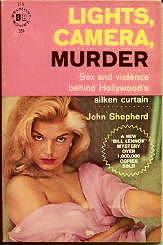
I’d better take that back. John Shepherd is a common enough name that it could have easily been the byline of plenty of books. In the interest of utmost accuracy, I’ll rephrase what I just said. This was the first mystery that any John Shepherd ever wrote.
What about Bill Lennox? Was he a mystery character who’d be immediately recognized as a hot sales commodity in 1960? He could have been, but if you’d like my best guess, probably not. Bill Lennox had last appeared in mystery form a mere six years before, in a book called Dealing Out Death, published as a paperback reprint in 1954 by an obscure company called Graphic Books. The byline? Not John Shepherd. The byline for Dealing Out Death was W. T. Ballard. It would have taken a lot of rather esoteric knowledge on the part of a would-be buyer before this book would have snapped up off the newsstand on the basis of this particular sales pitch.
Of course, maybe you know all of this, and I’m berating the unberatable, not now, not almost 50 years later. (And by the way, my spell-checker doesn’t know that word either.) Both Bill Lennox and W. T. Ballard have come up for discussion here on the Mystery*File blog not too long ago, mostly, as you’ll recall, in relation to his pulp magazine appearances in Black Mask between 1933 and 1942.
As mentioned then, but it’s worth repeating now, when he stopped writing about him for the pulp fiction magazines, Ballard took his character over to book-length hardcover cases, but unlike Erle Stanley Gardner, neither he nor Bill Lennox managed to succeed very well in making the transition. While putting together a more comprehensive, detailed list of the books that Bill Lennox, the Hollywood trouble-shooter, appeared in, I decided to go all out and using Al Hubin’s Crime Fiction IV as a guide, come up with a list of all of Ballard’s crime fiction in book length form:
The Bill Lennox books:
Say Yes to Murder. Putnam, 1942. Penguin 566, pb, October 1945. Reprinted as The Demise of a Louse, as by John Shepherd. Belmont 91-248, pb, 1962.
Murder Can’t Stop. McKay. 1946. Graphic #26, pb, 1950.
Dealing Out Death. McKay, 1948. Graphic #72, pb, 1954.
Lights, Camera, Murder, as by John Shepherd. Belmont 215, pbo, 1960.
The Tony Costaine/Bert McCall books, as by Neil MacNeil:
Death Takes an Option. Gold Medal 807, pbo, September 1958.
Third on a Seesaw. Gold Medal s844, pbo, January 1959.
Two Guns for Hire. Gold Medal s898, pbo, July 1959.
Hot Dam. Gold Medal 964, pbo, January 1960.
The Death Ride. Gold Medal 1005, pbo, November 1960.
Mexican Slay Ride. Gold Medal s1182, pbo, January 1962.
The Spy Catchers. Gold Medal d1658, pbo, 1966.
The Lt. Max Hunter books:
Pretty Miss Murder. Permabook M-4228, pbo, December 1961.
The Seven Sisters. Permabook M-4258, pbo, October 1962.
Three for the Money. Permabook M-4297, pbo, November 1963.
Non-series books:
Murder Picks the Jury, as by Harrison Hunt. [Co-written with Norbert Davis.] Samuel Curl/Mystery House, 1947.
Walk in Fear. Gold Medal 259, pbo, September 1952. [Based on “I Could Kill You,” a story that appeared in The Shadow magazine in 1948.]
Chance Elson. Cardinal C-277; pbo, November 1958.
Age of the Junkman, as by P. D. Ballard. Gold Medal d1352, pbo, 1963.
End of a Millionaire, as by P. D. Ballard. Gold Medal d1486, pbo, 1964.
Murder Las Vegas Style. Tower 42-778, pbo, 1967.
Brothers in Blood, as by P.D. Ballard. Gold Medal T2563, pbo, 1972.
The Kremlin File, as by Nick Carter. Award AN1165, pbo, 1973.
The Death Brokers, as by P.D. Ballard. Gold Medal M2867, pbo, 1973.
After World War II, W. T. Ballard seems to have been more successful in writing westerns than he was with his mystery fiction, but I haven’t taken the time to do any research in that particular direction. And this review is nominally of Lights, Camera, Murder, so let’s get back to that, shall we?
Sadly to say, however, and I’ll say this upfront, this is a book that’s little more than ordinary, and in some ways less. It is, after all, as Bill Pronzini has pointed out to me, a book that was published under a never-before-used pseudonym and put out by a second-rate publisher. On the other hand, I read the book all the way through, and I can’t say that about every book I pick up to read.
The greatest appeal this book probably has today is to completists: those who want every Bill Lennox story there is to read; or those who want every novel that W. T. Ballard wrote; or simply those who collect everything that Belmont ever published. (These completists have been arranged in order of decreased (although not negligible) likelihood. My spell-checker doesn’t recognize the word completist either, but we know you’re out there, don’t we?)
To begin at the beginning, though, the story begins when Lennox is called upon to salvage a movie that’s in production down in Mexico, where one of the leading male stars has been found knifed to death in his room. The leading female star is in jail for the crime, having been seen leaving his room quietly the night before. This is the kind of disastrous situation in which a legendary trouble-shooter is always called upon to save the day, and quickly.
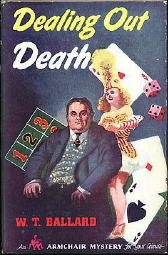
In quick order we are re-introduced to Sol Spurk, the head of the studio and the only man that Lennox reports to. In the pulp stories, though, I am sure he spelled his last name as Spurck, and sure enough, on page 97, it is spelled that way too. We also meet Lennox’s steady girl friend, a movie columnist named Nancy Hobbs, although very briefly. Their relationship is a loose one, meaning that neither places any restrictions on the other.
Which is a good thing, one realizes quickly on, as Lennox does not offer much resistance, first of all, to the leading star (Sylvia Armstrong) who is in jail for the crime she did not commit, or so she says, even though she was seen leaving his room during the night the murder was committed. Since she is in essence a victim of nymphomania, perhaps what she says may not entirely be the truth, even though the dead man was said to be homosexual.
But it is the beautiful and unsullied Candy Kyle, new to motion pictures, motion picture making and motion picture people, whom Lennox finds himself falling for. On her part, she serves as his assistant in crime-solving by keeping tabs of people, knowing where they are or should be, being shot at together, and being rammed on the open sea by power craft together.
This is, as you fully well realize, the way that bad guys have of warning detectives off. It is also the approach which of course never works, even with high rolling gamblers and drug kingpins calling the shots, and is rather typical of the clichés and not-very-involving story line that ensue as soon as Lennox crosses the Mexican border.
Lennox’s past, which began back in 1933, as you may recall, has been updated into the TV era and the age of beatnicks (sic) and the aforementioned drug-pushing industry. On page five, past history irregardless, it is said that he has had a ten year’s tenure working for Spurk. The usual time compression procedure is at play here, and don’t get me wrong. It’s happened to the best of fictional detectives, from Perry Mason, Hercule Poirot on down, though perhaps their creators were less blatant about it.
The plot itself is not very interesting, as I suggested before. If anything, I was more interested in the players themselves. Even though some come from solid stock companies, some, including Lennox, came to life, including Candy Kyle, and some more than others.
Speaking of which, the ending is a wowser, one of those endings that really make you wonder what is going to happen next. Except, of course, there was no “next.” This is all he wrote.
— June 2007
« Previous Page
